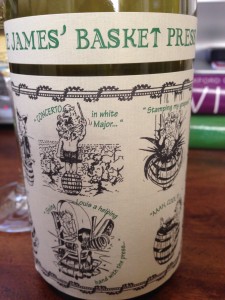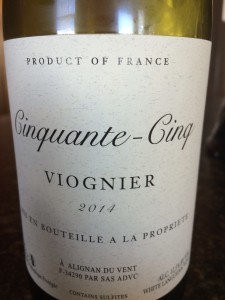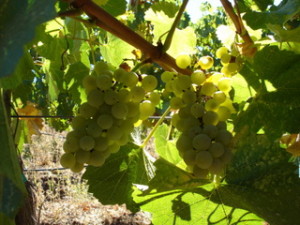Episode 45: Grape Gab – Viognier, The Grape of The Day. Yo.
The wine, the where, the legend, and factoids galore are all part of our fun exploration of the Viognier grape which sometimes, let’s be honest, just doesn’t get enough love. We talk about where it came from, where it grows now, and what you can find in the glass! We have #W25Challenge updates, new reviews, upcoming events, and lots of love to shout out. Thank you for joining us and sipping along!
Steph: “Welcome Wine-Two-Five listeners! Thank you so much for joining us for Episode 45! I’m Steph, and I’m here with Val.”
Val: “Hello Steph and greetings Wine Two Fivers – hopefully you’re having a great week. Happy #ThirstyThursday! Speaking of thirsty, I know I’m ready to start sipping – what’s in your glass Steph?”
Drinking:
Val: “Little James’ Basket Press, Viognier/Sauvignon Blanc Blend. What?? IGP Languedoc – funny how we both went to the same region! It’s from Minervois in the Languedoc-Roussillon and made with what they call an “ancient” Viognier variety or “selection massale” planted in 1982. This is a fun little sip for $15/bottle. ”
Discussion: Viognier
Val: “This leads into our discussion topic today. We’re going to have a little grape gab today about Viognier. Word.”
Where it is from: “This is a white grape that is native to the Rhone valley area which is south of the French city of Lyon.
History & Origin: It was first mentioned in French literature in the late 18th century in association of the wines of the Northern Rhone. It is related to the Syrah grape as well, which makes sense since that is the primary red grape of the same area.
There are legends that the grape may have been brought to France from the Dalmatian coastal area of Croatia, possibly by an emperor, Roman Probus in the 3rd century. Romans were responsible for a lot of viticultural development throughout France, however, according to Jancis Robinson (Wine Grapes, 2012) there is no evidence of this being historically proven, and in addition the grapes grown there now, called, Vugava or Bugava, are not a DNA match for the Viognier that we know and love today.”
Steph:
Where it is now: “While the Chateau Grillet and Condrieu appellations are certainly the most well known, you’ll find it in Southern Rhone, Languedoc-Roussillon also.
“It is grown around the world, but only a small amounts in Spain (Castilla-La Mancha), Italy (the Maremma, which is part of Tuscany, Sicily, and a few producers in Lazio & Piemonte). Greece, Turkey, Hungary, Austria, and Israel all grow minute bits of Viognier as well.
“In the new world, however, this grape has really taken off! Australia, South America, California, and Virginia are champions of the variety. In fact (hello factoid, in Virginia, the state’s signature grape is Viognier!)
“Anywhere it’s fairly warm, the Viognier grows really well.”
In the Glass: “It’s highly aromatic when fully ripened, and creates medium to full-bodied wines that make a great alternative to Chardonnay! Aromas can range from ripe stone fruit (peaches, apricots, nectarines), oranges, to honey, and it is particularly floral (jasmine, violets). It can often be lower in acid than some expressions of Chardonnay, and is often not subjected to heavy oak use which makes it a great option for those “ABC” folks – ‘Anything But Chardonnay.’ Alcohol can be medium (+) to high due to its ability to ripen and concentrate sugars, but has a rich, warming and sometimes luscious mouth feel, depending on the style!”
Factoid:
Val: “So the factoid this week has to do with the fact that Viognier not only makes a great white wine, but is also added to some red wines during the fermentation process. This is called “co-fermentation”. Up to 20% can be added to Cote Rotie Reds where it is sometimes planted alongside the Syrah and harvested with it, although not always, as the grapes can have different ripening times. There are producers doing the same thing in Australia and California as well.
“Why do they do this? We’re glad you asked! Remember when you blend grapes that each grape brings something special to the party. In this case, the co-fermentation of Viognier with Syrah brings more floral aromas and is believed to lift the intensity of the finished wines aromas. Additionally, this process of co-fermentation can aid in stabilizing and intensifying the wine’s color through what they call, ‘co-pigmentation.’
“So there you go – next time you have a bottle of Cote Rotie Syrah, or possibly a California or Australian Syrah/Shiraz, there may be some Viognier in your red adding that extra boost of joy.”
Shoutouts:
Steph: “Our latest review on iTunes – thank you TSPArusty for this review titled “Entertaining!” Love these two ladies! They are always fun to listen to and make wine education very entertaining!”
Val: “And our latest comment from Bike-to-Wine on our Libsyn site: Stephanie and Val bring such a great mix of knowledge, experience, exposure to new wines and regional varietals, interesting factoids, laid-back fun, and a much needed sense of wine community for those of us who are mesmerized by the infinite possibilities of the grape, especially when paired with food and friends! Wishing you the best, and keep the fun coming!”
#W25 Challenge
From Susan on Facebook:
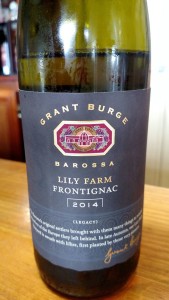
“Wow…got to try a Frontenac white at Grant Burge and blend with a saperavi at Artisans of the Barossa so far today…what a #W25Challenge adventure! — at Barossa Valley.”
From Lynn on Facebook:
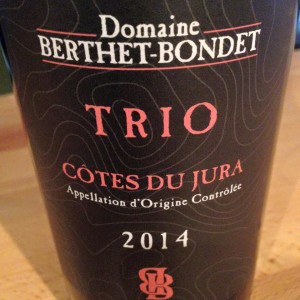
“#W25Challenge 1st Jura wine for me & the Poulsard grape. Domaine Berthet-Bondet Côtes du Jura Trio (40% Trousseau, 40% Poulsard, 20% Pinot Noir). Lighter style, big on flavor.#
From the boys at We Like Drinking on Twitter:
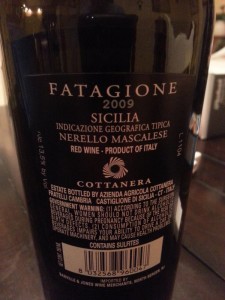
“Finally getting my #w25Challenge on with this Sicilian Nerello Mascalese. So many princess bride quotes come to mind”
Winoradar:
Steph: “2nd Annual Women of the Vine Symposium is SOLD OUT! … And thankfully, I registered just in the nick of time. So I will see you there if you are also attending. Please reach out to me if you are.
“Here’s a short description of the event and we’ll definitely have the link on our website for you to read more.
‘April 4-6, 2016 in Napa, CA –“The symposium brings together some of the best minds and leaders in the alcohol beverage world who want to grow their industry and support women’s careers,” said Founder and President of Women of the Vine, Deborah Brenner. “The demand for tickets is a telltale sign that gatherings like this are vital and that we’re clearly filling a void.”
The 2016 Women of the Vine Global Symposium aims to provide tangible strategies to help women further their careers within the ever-changing alcohol beverage world.'”
Val: “This Saturday at 10 a.m. CST the Society of Wine Educators is hosting an online Certification Summit for those seeking the CWE credential. We are featuring France’s smaller, lesser-known regions, such as Saint-Bris, Pacherenc-du-Vic-Bilh, Irouleguy and Rose’ des Riceys. It’s called “Little Fish” because these are the little wine fish in the big French wine pond of appellations. Registrations are required.”
